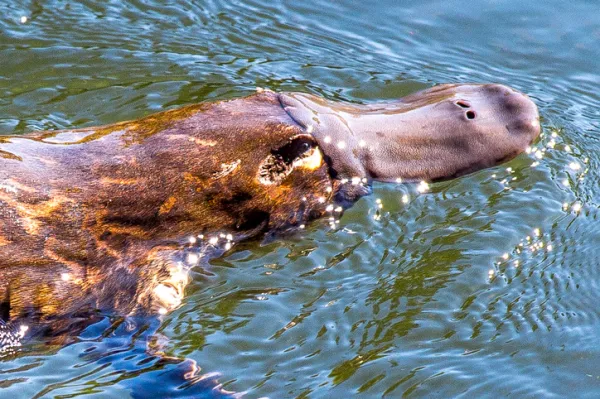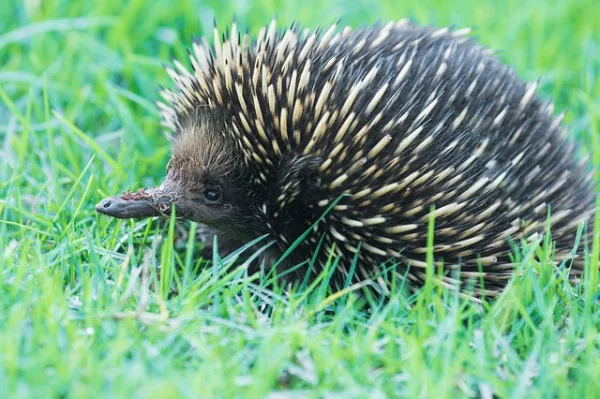Monotremes (order Monotremata) are the most unusual—and oldest living—branch of mammals. They blend traits typically seen in reptiles and birds with core mammalian features: they lay eggs, produce milk, and are covered in hair, yet they also retain a single cloaca (a shared opening for excretion and reproduction). Today, monotremes occur only in Australia, Tasmania, and New Guinea, and are rarely encountered in the wild.

Name & meaning: Monotremata comes from Greek for “single opening,” referring to the cloaca, a feature they share with birds and reptiles.
Evolutionary position: Within Mammalia, monotremes belong to the subclass Prototheria. They share a common ancestor with marsupials (Metatheria) and placental mammals (Eutheria), but followed a distinct evolutionary path.
Geologic origin: Fossils and genetic data indicate monotremes were already present at least 110 million years ago (Early Cretaceous).
Living members: Generally recognized as one species of platypus plus echidnas (one short-beaked species and two–three long-beaked species, depending on the taxonomy). In practice, you’ll see 4–5 living species cited.

Egg-laying mammals: The only living mammals that lay eggs. Their eggs are leathery (not hard-shelled), resembling those of reptiles and birds.
Small clutch, altricial young: Typically 1–2 eggs per season. Hatchlings are extremely underdeveloped, relying on the mother for warmth and transport.
Milk delivery without nipples: Females lack nipples; milk oozes from specialized mammary skin patches, and young lap it from the fur.
Sex chromosomes: Unlike placentals and marsupials (typically one X/Y pair), monotremes use five pairs of sex chromosomes. Some sequences show similarity to the avian Z chromosome.
Lower, more variable body temperature than other mammals (often around 31–32 °C), with a comparatively low metabolic rate—an energy-saving strategy.
Cloaca: A single opening for urinary, digestive, and reproductive tracts.
Dentition: Hatchlings may bear primitive teeth to help break the egg; adults lack true teeth, using keratinized pads or beaks to process food.
Mammalian ear: They possess the three middle-ear bones typical of mammals.
Limb posture & shoulder girdle: More “reptile-like” and sprawling than in other mammals—considered a primitive trait.
Special senses: Platypuses have electroreception and mechanoreception in the bill to detect prey; echidnas have highly sensitive snouts for probing soil and nests.
Venomous spur: Male platypuses carry a keratin spur on the hind leg connected to a venom gland (especially active in breeding season) used in male–male competition and defense.
Insulation & protection: Echidnas have dense spines over coarse fur; platypus fur is waterproof and insulating for cold streams.
Diet & habits: Most feed on invertebrates (aquatic larvae, worms, crustaceans, ants, termites) and are adapted to riverbanks, forests, and montane habitats.

Range: Eastern Australia and Tasmania in rivers, creeks, and wetlands.
ID features: A broad, soft-tissue bill, webbed feet, and a flattened tail. Body length about 40 cm (tail excluded).
Behavior & feeding: Expert swimmer and burrower; crepuscular/nocturnal; hunts benthic invertebrates using electroreception in murky water.
Venomous spur: Males have a functional hind-leg spur—stings are intensely painful.
Conservation notes: Locally common but threatened by pollution, river regulation, bycatch in nets, and habitat loss.
Range: Australia, Tasmania, and parts of New Guinea.
ID features: 50–75 cm long; spines + coarse fur; short, tubular toothless snout with long sticky tongue.
Diet & behavior: Specializes on ants and termites; powerful foreclaws for digging nests and defense.
Reproduction: Lays a single egg into a temporary pouch; the hatchling “puggle” is carried against the mother’s belly and licks milk from mammary patches.
Status: Widespread but sensitive to fire regimes and land-use change.
(Usually treated as 2–3 species, all New Guinea highland endemics, larger than the short-beaked echidna.)
Species commonly recognized:
Western Long-beaked Echidna (Z. bruijni)
Eastern Long-beaked Echidna (Z. bartoni)
Attenborough’s Long-beaked Echidna (Z. attenboroughi) in some classifications
Range & habitat: Montane rainforests and alpine scrub, sometimes above 3,000 m.
ID features: Long, slender snout, massive digging claws, dense spines.
Diet: Soil-dwelling invertebrates and larvae; digs deeply to extract prey.
Defense: Curls into a spine-ball or “dives” into soil when threatened.
Conservation: Generally Endangered to Critically Endangered due to habitat loss, hunting, and predation by dogs; field sightings are rare and monitoring is difficult.
Shared mammalian hallmarks
Hair, lactation, and three middle-ear bones; mammalian jaw joint.
Distinctive differences
Egg-laying, cloaca, no nipples, lower body temperature, and retention of primitive skeletal traits; unique electroreception (platypus) and hind-leg spur venom (male platypus).
Monotremes reveal an alternative mammalian strategy: egg-laying plus lactation, low metabolic demands, and remarkable sensory and defensive adaptations. Whether it’s the electrosensory, semi-aquatic platypus or the armor-spined echidnas that “swim” through soil, these living relics from deep time are essential to understanding the origins and ecological breadth of mammals.
Bibliography
Martinelli, A., Forasiepi, A. & Rougier, G. (2008) Australosphenids: Close relatives of the enigmatic monotremes. Ciencia Hoy Magazine, Volume 18 (104).
Flores, D. (2015) Handbook of the Mammals of the World: Monotremes and Marsupials. Lynx Editions, Argentine Society for the Study of Mammals of Tucumán, Argentina, Vol. 22 (2), pp: 423-424.
Bruna, C. (2008) Venomous Animals: Poisonous Terrestrial Vertebrates Dangerous to Humans in Spain. Naturalist Association of Aragon (ANSAR), pp: 32-34.
animal tags: monotremes
We created this article in conjunction with AI technology, then made sure it was fact-checked and edited by a Animals Top editor.